A treasure trove of art and archaeology, this museum offers a window into the rich tapestry of cultures that have shaped this Andalusian gem. From its Phoenician roots to its Roman, Moorish, and Christian influences, every artifact and artwork tells a story. As we embark on this journey through the museum’s corridors, we’ll uncover tales of conquests, artistic revolutions, and the indomitable spirit of the Malagan people.


Manuel Rodriguez
Table of Contents
- The Historical Significance of Museo de Malaga
- Ignite Your Passion for Spanish with Us!
- The Palacio de la Aduana
- The Archaeological Collection
- The Fine Arts Collection
- Contemporary Voices: Art in the Present
- Celebrating Local Talents
- Interactive Exhibits and Multimedia
- Visiting the Museum: Practical Information
The Historical Significance of Museo de Malaga
The Museo de Malaga is not merely a repository of artifacts and artworks; it is a chronicle of a city’s soul, a reflection of its vibrant history, and a testament to its cultural evolution. Situated in the heart of Malaga, this museum stands as a beacon, illuminating the city’s journey through time.
Malaga, with its strategic location along the Mediterranean coast, has been a coveted prize for numerous civilizations. From the ancient Phoenicians who established trade routes to the Romans who built theaters and aqueducts, each era left its indelible mark. The Museo de Malaga captures this confluence, showcasing how each civilization contributed to the city’s unique cultural mosaic.
The museum offers a deep dive into the Moorish era, a period that significantly shaped Andalusia’s architecture, art, and daily life. The intricate ceramics, ornate jewelry, and architectural remnants from this period are a testament to the Moors’ artistic and scientific prowess. However, the narrative doesn’t stop there. The Christian Reconquest, which saw the blending of Moorish and Christian traditions, is equally represented, highlighting the synthesis of two distinct cultures.
As Europe underwent a renaissance, so did Malaga. The museum’s collection from this period showcases the city’s artistic evolution, from classical sculptures to avant-garde paintings. The transition from traditional to modern is evident, reflecting Malaga’s adaptability and its artists’ desire to push boundaries.
Beyond its exhibits, the Museo de Malaga itself is a symbol of the city’s commitment to preserving its heritage. The decision to house the museum in the Palacio de la Aduana, a neoclassical architectural gem, underscores this commitment. The building, with its grand arches and ornate facades, adds another layer to the museum’s historical narrative.
In essence, the Museo de Malaga is more than a tourist attraction. It is a journey through epochs, a celebration of Malaga’s multifaceted identity, and a reminder of the city’s enduring spirit. Through its halls, one doesn’t just observe history; one experiences it.
Ignite Your Passion for Spanish with Us!
Are you ready to dive into a new language and immerse yourself in a vibrant culture? Whether you’re dreaming of the bustling streets of Buenos Aires, the sun-soaked beaches of Malaga, or the convenience of learning from the comfort of your own home, we’ve got you covered!
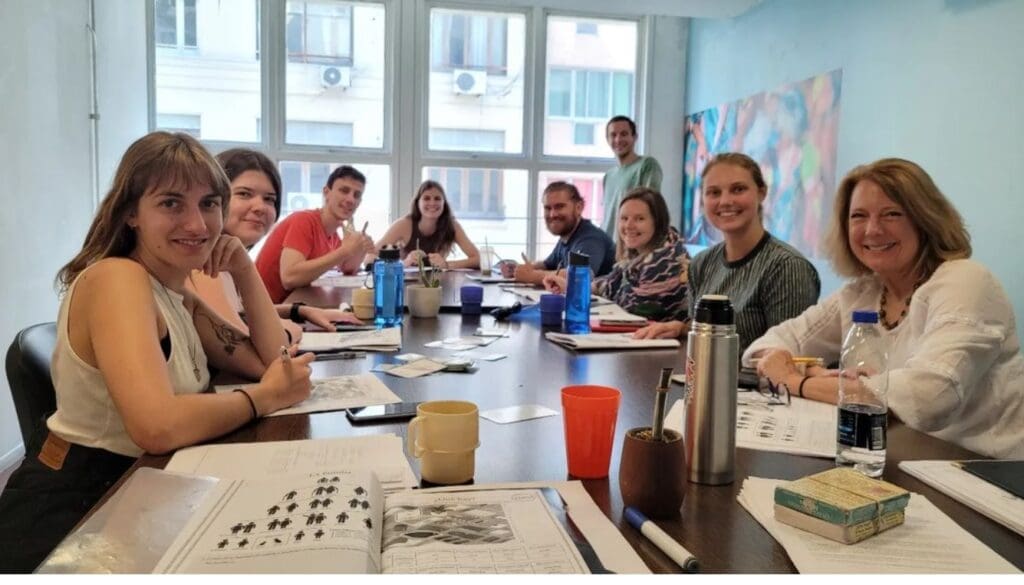

Experience Buenos Aires
Join us at our language school in Argentina. Immerse yourself in the local culture, explore the city’s rich history, and let the rhythm of Buenos Aires fuel your language learning journey.
Discover Malaga
Picture yourself learning Spanish under the warm Andalusian sun. Our Spanish school in Malaga offers a unique blend of high-quality education and a relaxed, beach-side lifestyle. It’s more than just a language course, it’s the adventure of a lifetime!
Learn Spanish Online
If travel isn’t on the cards right now, don’t worry! Our online Spanish classes bring the language to you. Enjoy interactive, engaging lessons with our experienced teachers, all from the comfort of your own home.
The Palacio de la Aduana
The Palacio de la Aduana, translating to the Customs Palace, is not just a building; it’s a masterpiece that stands as a testament to Malaga’s architectural heritage. Its grandeur and design intricacies make it one of the city’s most iconic landmarks, and its transformation into the Museo de Malaga has only added to its significance.
Origins and Historical Background
Constructed towards the end of the 18th century, the Palacio de la Aduana stands as a symbol of Malaga’s rich maritime heritage. Given Malaga’s strategic position along the Mediterranean coast and its reputation as a thriving port city, there was a pressing need for a dedicated customs house to manage the growing trade activities. Recognizing this, King Charles III took the initiative to commission a grand edifice that would not only serve the practical needs of the city but also reflect its burgeoning status in the region.
The design of the Palacio was meticulously planned to facilitate the efficient handling of the vast array of goods and commodities that poured into Malaga’s docks. From spices and textiles from the East to precious metals from the New World, the port was a hive of activity, and the Palacio de la Aduana was at its heart. The building was equipped with spacious storage rooms, inspection areas, and administrative offices, all designed to streamline the customs process and ensure that trade flowed smoothly.
Moreover, the architectural grandeur of the Palacio was not just for show. It was a statement of intent, signaling Malaga’s ambition and its pivotal role in the trade networks of the time. The intricate facades, grand archways, and ornate detailing of the building were a testament to the city’s prosperity and its central position in the economic landscape of 18th century Spain.


Neoclassical Elegance
The Palacio de la Aduana, with its majestic presence, stands as a quintessential representation of neoclassical architecture, a style that emerged in the mid-18th century as a reaction to the ornate and elaborate designs of the Baroque period. This architectural style, inspired by the classical art and culture of Ancient Greece and Rome, emphasizes proportion, simplicity, and timeless elegance.
At first glance, the Palacio’s design captivates the observer with its perfectly symmetrical facades. This symmetry, a hallmark of neoclassical design, imparts a sense of balance and harmony to the structure. Complementing this symmetry are the grand columns that grace the entrance, reminiscent of ancient Greek temples. These columns, with their detailed capitals, not only provide structural support but also add a touch of grandeur to the building’s exterior.
Further enhancing the Palacio’s aesthetic appeal is its intricate detailing. The exterior is punctuated by a series of gracefully curved arches and vertical pilasters, which break the monotony of the walls and add depth and dimension. These architectural elements, while functional, are also decorative, showcasing the meticulous craftsmanship of the artisans of the time.
Also read our blog about: The Best Bars In Malaga: All You Need To Know About
Stepping inside the Palacio, one is immediately transported to a world of luxury and refinement. The interiors are a visual feast, with walls adorned with intricate frescoes depicting scenes from mythology and history. These frescoes, painted by skilled artists, bring color and life to the rooms, telling stories and evoking emotions. Complementing the frescoes are decorative moldings that line the ceilings and doorways, adding layers of texture and sophistication.
However, the pièce de résistance of the Palacio’s interiors is undoubtedly its central courtyard. This open space, surrounded by the building’s wings, is a marvel of design. Laid with pristine marble floors that reflect the sunlight, the courtyard exudes an airy and luminous ambiance. Dominating this space are the cascading staircases, which, with their fluid design, seem to flow like water. These staircases, made of the finest marble, are not just functional pathways but also works of art, showcasing the opulence and luxury of the era.
In essence, the Palacio de la Aduana’s design is a masterclass in neoclassical architecture. Every element, from the grand columns to the delicate frescoes, has been thoughtfully chosen and meticulously executed, offering a window into the artistic and architectural sensibilities of the 18th century.
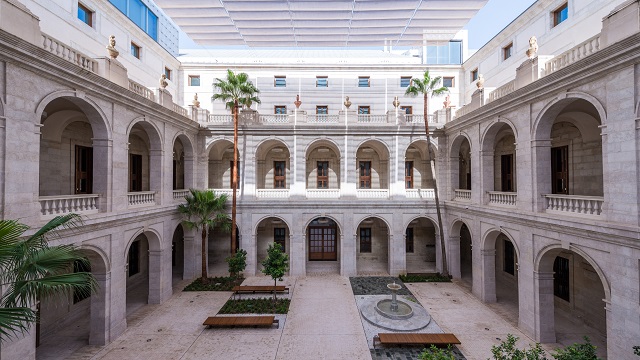
Restoration and Transformation
Over the passage of time, the Palacio de la Aduana witnessed the ebb and flow of history, undergoing numerous modifications that reflected the changing needs and aspirations of the city. As Malaga evolved, so did the role of the Palacio. From its initial days as a bustling customs house to its various other incarnations, the building’s purpose was continually redefined, mirroring the city’s dynamic spirit.
However, the dawn of the 21st century brought with it a pivotal moment in the Palacio’s history. The decision to house the Museo de Malaga within its walls was not taken lightly. This was not merely a matter of repurposing an old building for a new function; it was a conscious effort to intertwine the rich tapestry of Malaga’s past with its present and future. The Palacio, with its deep historical roots, was deemed the perfect venue to showcase the city’s artistic and archaeological treasures.
The transformation of the Palacio into the Museo de Malaga was a monumental task. The challenge lay in striking a balance between preserving the building’s historical integrity and equipping it with modern amenities to serve as a state-of-the-art museum. Every brick, every archway, and every fresco was treated with reverence, ensuring that the essence of the Palacio was not lost in the restoration process.
Architects, historians, and conservationists collaborated closely, pouring over old blueprints, photographs, and documents to understand the Palacio’s original design. This meticulous research was crucial in guiding the restoration efforts. While the exterior was carefully restored to its former neoclassical glory, the interiors were revamped to create spacious galleries, climate-controlled display areas, and interactive exhibits, all designed to enhance the visitor’s experience.
Also read our blog about: Exploring Malaga’s Historic Center: A Comprehensive Guide
Special attention was given to the central courtyard, ensuring that its marble floors and cascading staircases retained their original splendor. Modern lighting techniques were employed to highlight the architectural details, and advanced security systems were installed to safeguard the priceless artifacts.
In essence, the transformation of the Palacio de la Aduana into the Museo de Malaga was a labor of love, a testament to the city’s commitment to celebrating its heritage. The result is a harmonious blend of the old and the new, where history comes alive amidst modern comforts, offering visitors a journey through time in the heart of Malaga.
A Living Legacy
Today, the Palacio de la Aduana stands as a bridge between the past and the present. While its walls echo tales of bygone eras, its galleries are filled with artifacts that chronicle Malaga’s journey through time. The building itself is a testament to the city’s commitment to preserving its architectural gems, ensuring that future generations can marvel at its beauty and significance.
The Archaeological Collection
The Archaeological Collection of the Museo de Malaga stands as a testament to the city’s rich and layered history. Each artifact, carefully curated and displayed, offers a tangible link to the past, providing insights into the lives, cultures, and innovations of the civilizations that once thrived in this region.


Prehistoric Beginnings
The journey begins with the relics from the prehistoric era, a time when early humans first settled in the region. From primitive stone tools to ancient pottery shards, these artifacts shed light on the daily lives and survival strategies of Malaga’s earliest inhabitants. Highlights include cave paintings and early hunting implements, which offer a glimpse into the rituals, beliefs, and societal structures of these ancient communities.
Another Museum in Malaga: The Centre Pompidou in Malaga
The Phoenician Legacy
The Phoenicians, renowned as master seafarers and traders, were among the first to recognize the strategic importance of Malaga. Drawn by its natural harbor and proximity to vital trade routes, they established a thriving settlement that would grow into a bustling trade hub, attracting merchants and craftsmen from across the Mediterranean. Their presence in the region left behind a wealth of artifacts that stand as a testament to their unparalleled craftsmanship and aesthetic sensibilities.
Intricately designed jewelry, often made of gold and adorned with semi-precious stones, reflects the affluence of the Phoenician elite. These pieces were not just ornamental but also symbolic, representing status, power, and religious affiliations. The presence of Phoenician coins in the region underscores their influence in shaping the local economy. These coins, often bearing the likeness of deities or rulers, facilitated trade and commerce, highlighting the Phoenicians’ sophisticated economic systems and their far-reaching trade networks that spanned from the Levant to the Iberian Peninsula.


Phoenician pottery offers another window into their daily life and artistic expressions. These vessels, ranging from simple storage jars to ornate amphorae, were used for various purposes, including storing wine, oil, and grains. The intricate patterns and symbols painted on these pottery pieces provide clues about the Phoenicians’ myths, legends, and interactions with other cultures.
Perhaps one of the most remarkable pieces left behind by the Phoenicians is a sarcophagus, intricately carved with scenes from mythology and daily life. This burial artifact indicates the importance the Phoenicians placed on burial rituals and offers insights into their beliefs about the afterlife. The detailed carvings and inscriptions on the sarcophagus serve as a poignant reminder of the rich cultural tapestry that the Phoenicians wove in Malaga, leaving an indelible mark on its history.
Roman Footprints
The Roman Empire, with its vast expanse and unparalleled might, left an indelible mark on many regions, and Malaga was no exception. As the empire expanded its territories, Malaga became an integral part of the Roman world, serving as a crucial port and trade center. The remnants from this era, meticulously preserved in the collection, offer a comprehensive glimpse into the Roman way of life and their profound influence on the region.
Well-preserved mosaics are among the standout artifacts from the Roman era. These intricate artworks, crafted with minute tesserae, adorned the floors and walls of Roman villas and public buildings. Each mosaic tells a story, whether it’s a depiction of Roman myths, scenes from daily life, or intricate geometric patterns. Their vibrant colors and detailed designs showcase the artistic prowess of Roman craftsmen and the opulence of the era.
Statues, often carved from marble or bronze, are another highlight of the Roman collection. These statues, ranging from lifelike busts of emperors and deities to full-sized figures of citizens, provide insights into Roman fashion, ideals of beauty, and societal hierarchies. The attention to detail, from the intricate drapery of the robes to the expressive facial features, is a testament to the skill and artistry of Roman sculptors.
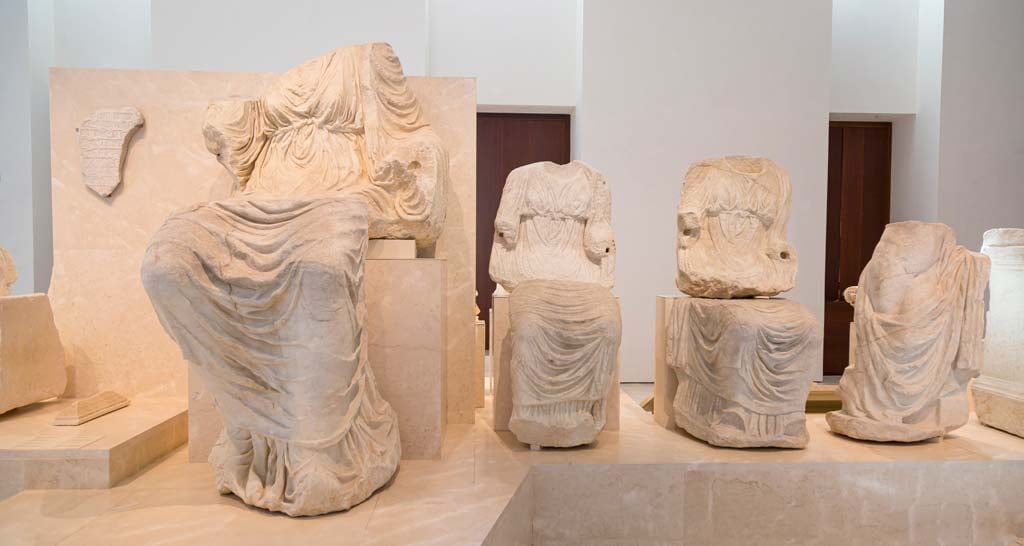

Architectural fragments from this period further underscore the grandeur of Roman architecture. Ornate columns, capitals, and friezes that once graced Roman temples, theaters, and bathhouses can be seen in the collection. These pieces, with their classical motifs and designs, reflect the architectural innovations of the Romans and their penchant for monumental structures.
Beyond these artistic and architectural marvels, the collection also houses everyday items that offer a more intimate look into daily life in Roman Malaga. Cooking utensils, made of bronze or terracotta, give a sense of the Roman culinary landscape. Amphorae, the characteristic Roman pottery vessels, were used for storing and transporting wine, oil, and other commodities, highlighting the trade activities of the time. Inscriptions, often carved on stone tablets or metal plaques, provide valuable information about Roman laws, decrees, and personal dedications.
In essence, the Roman artifacts in the collection weave together a multifaceted narrative of Roman Malaga. From the grandeur of its public buildings and the artistry of its villas to the hum of its bustling markets and the rhythm of its daily life, these remnants transport visitors back in time, allowing them to walk in the footsteps of the Romans who once called Malaga home.
Moorish Splendor
The Moors, with their rich cultural heritage and advanced knowledge, played a pivotal role in shaping the history and landscape of Malaga. Their reign, spanning several centuries, brought about a renaissance of art, science, and architecture in the region. The artifacts from this era, meticulously curated in the collection, offer a deep dive into the Moorish way of life, their artistic sensibilities, and their profound influence on Malaga.
Ceramic works from the Moorish era are a testament to their mastery over pottery and ceramics. These pieces, often adorned with intricate geometric patterns, floral motifs, and calligraphic inscriptions, were not just utilitarian but also works of art. The vibrant glazes, combined with the precision of the designs, reflect the Moors’ deep understanding of chemistry and geometry. From ornate tiles that decorated palatial walls to everyday vessels used for storage, these ceramic artifacts provide insights into both the daily life and the artistic endeavors of the Moors.
Metalwork from this period further underscores the Moors’ expertise in craftsmanship. Items such as ornate lamps, incense burners, and jewelry were crafted with precision from metals like bronze, silver, and gold. The intricate filigree work, inlay techniques, and detailed engravings on these items showcase the Moors’ attention to detail and their ability to meld form and function seamlessly.
Also read our blog about: Parque del Oeste in Malaga: A Hidden Gem
Textile fragments from the Moorish era offer a glimpse into the fashion and textile industry of the time. These fragments, often woven with silk and adorned with gold or silver threads, highlight the luxury and opulence of Moorish attire. The intricate patterns and designs on these textiles, combined with their vibrant colors, provide insights into the Moors’ aesthetic preferences and their mastery over weaving and dyeing techniques.
Perhaps the most telling remnants of the Moors’ architectural prowess are the architectural fragments scattered throughout the collection. These pieces, ranging from ornately carved wooden beams and plasterwork to decorative tiles and stone carvings, hint at the grandeur of the Moorish structures that once stood tall in Malaga. The arches, domes, and intricate latticework are indicative of the iconic Moorish architectural style, which was heavily influenced by their Islamic beliefs and their interactions with other cultures.
In essence, the Moorish artifacts in the collection paint a vivid picture of a time when Malaga was a melting pot of cultures, ideas, and innovations. The Moors, with their advanced knowledge and artistic flair, transformed the city into a beacon of enlightenment, leaving behind a legacy that continues to inspire and captivate visitors to this day.
Christian Reconquista and Beyond
Following the Reconquista, a monumental event that marked the Christian reclamation of the Iberian Peninsula, Malaga found itself at the crossroads of two powerful and distinct cultures: the Moors and the Christians. This period of transition, replete with both collaboration and conflict, ushered in a new era for the city, the remnants of which are beautifully encapsulated in the collection.
Religious artifacts from this post-Reconquista period are particularly telling of the city’s evolving spiritual landscape. While the Moors had left an indelible Islamic imprint on Malaga, the Reconquista saw a resurgence of Christian practices and beliefs. Intricately crafted crucifixes, rosaries, and religious icons made of wood, metal, and stone began to emerge, symbolizing the renewed Christian fervor. Alongside these, one can still find artifacts bearing Islamic motifs and calligraphy, a testament to the enduring Moorish influence.
Manuscripts from this era offer a window into the intellectual and literary pursuits of the time. These handwritten documents, often illuminated with gold and vibrant colors, cover a range of subjects from religious texts and philosophical treatises to poetry and historical chronicles. The blending of Moorish and Christian styles is evident in the scripts, illustrations, and motifs found in these manuscripts. They serve as a testament to the city’s rich scholarly tradition and the confluence of two great civilizations.


Weaponry from the post-Reconquista period provides insights into the military and strategic aspects of the time. Swords with ornate hilts, shields adorned with heraldic symbols, and armor pieces reflect the martial prowess of the era. These weapons, often bearing inscriptions and motifs from both Moorish and Christian traditions, were not just tools of warfare but also symbols of power, honor, and lineage.
Architecturally, Malaga began to see a fusion of styles. While the grandeur of Moorish palaces and mosques remained, new Christian structures, including cathedrals, monasteries, and fortresses, began to dot the cityscape. The architectural elements from this period, such as the Gothic arches, Renaissance facades, and Baroque embellishments, seamlessly integrated with the existing Moorish designs, leading to a unique architectural tapestry that defines Malaga to this day.
In essence, the post-Reconquista artifacts in the collection narrate a tale of a city in flux, grappling with its identity, yet forging a path that harmoniously blended the best of both Moorish and Christian worlds. This period of synthesis not only shaped Malaga’s cultural and architectural heritage but also laid the foundation for the diverse and inclusive city it is today.
Special Exhibits and Recent Discoveries
The Museo de Malaga, while deeply rooted in the city’s rich history, is not a static institution. Instead, it pulsates with the vibrancy of ongoing archaeological endeavors, ensuring that the tapestry of Malaga’s past is continually enriched and expanded upon. This commitment to dynamism and evolution is evident in the museum’s approach to its archaeological collection.
Recent discoveries and excavations play a pivotal role in augmenting the museum’s offerings. As archaeologists unearth new artifacts, be it from ancient burial sites, forgotten settlements, or historic urban centers, these treasures find their way to the museum’s hallowed halls. Each item, whether it’s a fragment of ancient pottery, a long-lost manuscript, or a relic from a bygone era, adds a new chapter to the story of Malaga. These discoveries, often accompanied by cutting-edge research and analysis, shed light on previously unknown facets of the city’s history, culture, and daily life.
To ensure that visitors and enthusiasts are privy to these new findings, the Museo de Malaga frequently organizes special exhibits. These exhibits, curated with meticulous attention to detail, not only showcase the newly acquired artifacts but also provide context, weaving together narratives that bridge the past with the present. Interactive displays, multimedia presentations, and expert-led tours further enhance the visitor experience, making these exhibits both educational and immersive.
Moreover, these special exhibits serve as a testament to the museum’s collaborative spirit. Often, the Museo de Malaga partners with universities, research institutions, and international museums to bring these exhibits to life. Such collaborations foster a spirit of knowledge-sharing and ensure that the latest archaeological methodologies and insights are incorporated into the museum’s displays.
The Fine Arts Collection
The Museo de Malaga’s Fine Arts Collection stands as a testament to the city’s rich artistic heritage, spanning centuries and encompassing a myriad of styles, mediums, and influences. This collection, meticulously curated, offers visitors a journey through time, tracing the evolution of artistic expressions and the ever-changing socio-cultural landscape of Malaga.
Renaissance and Baroque Brilliance
The Renaissance and Baroque periods, often regarded as golden ages in the realm of art, ushered in a wave of creativity, innovation, and profound artistic exploration. The Museo de Malaga’s collection from these eras serves as a window into this transformative time, offering visitors a chance to witness the artistic genius that defined these centuries.
Renaissance
The Renaissance, a period marked by the revival of classical art, literature, and learning, saw artists breaking away from the rigid conventions of the medieval era. The collection boasts an array of Renaissance artworks that encapsulate the spirit of this renaissance. Majestic oil paintings from this period often focus on religious themes, drawing inspiration from biblical tales and Christian doctrines. These paintings, characterized by their balanced compositions and realistic portrayals, showcase the artists’ newfound fascination with human anatomy, perspective, and naturalism. Portraits from this era, often of nobility and influential patrons, are rendered with meticulous attention to detail, capturing the sitter’s likeness, emotions, and even their status in society.


Baroque
Following the Renaissance, the Baroque period emerged with its own distinct style, characterized by its opulence, drama, and emotional intensity. The collection’s Baroque pieces are a testament to the grandeur of this era. Religious scenes take on a more dramatic tone, with dynamic compositions, intense contrasts of light and shadow, and heightened emotional expressions. Mythological tales, another popular theme, are depicted with a sense of movement and theatricality, transporting viewers to a world of gods, heroes, and legends. The portraits from this period go beyond mere representation; they delve deep into the psyche of the subjects, capturing their innermost thoughts and emotions.
Check our blog about: Malaga’s Libraries in the Digital Age: A Comprehensive Overview
Mastery in Details
What sets the artworks from these periods apart is the artists’ unparalleled attention to detail. The play of light and shadow, known as chiaroscuro, adds depth and dimension to the paintings, making the scenes come alive. The nuanced expressions, whether it’s the serene gaze of a Madonna or the tumultuous emotions of a mythological figure, speak volumes about the artists’ understanding of human emotions and their ability to capture them on canvas.
Romanticism and Realism
As art evolved through the ages, the Romantic and Realist periods emerged as two distinct yet intertwined movements that sought to capture the essence of human experience in all its depth and diversity. The Museo de Malaga’s collection from these eras offers a rich tapestry of artworks that delve into the emotional landscapes and the tangible realities of the times.
Romanticism
The Romantic era, characterized by its emphasis on emotion, individualism, and nature, brought forth a wave of artworks that resonated with deep feelings and imagination. The collection’s Romantic pieces transport viewers to a world where emotions reign supreme. Dramatic landscapes, often depicting tempestuous seas, serene countrysides, or majestic mountains, evoke feelings of awe, wonder, and melancholy. These artworks, with their vibrant colors and dynamic compositions, capture the Romantics’ reverence for nature as a reflection of human emotions.
Portraits from this era delve deep into the human psyche, capturing the inner turmoil, passions, and dreams of the subjects. Whether it’s the wistful gaze of a poet or the defiant stance of a revolutionary, these paintings offer a glimpse into the hearts and minds of individuals who dared to challenge conventions and forge their own paths.


Realism: A Mirror to Society
In stark contrast to the emotional intensity of Romanticism, the Realist movement sought to depict life as it was, without the embellishments or idealizations. The collection’s Realist artworks provide an unfiltered view of everyday life in the 19th century. From bustling market scenes and humble rural settings to intimate domestic interiors, these paintings capture the mundane realities of the common man.
Realist artists, with their keen observational skills, portrayed the socio-economic challenges, cultural shifts, and urban transformations of the time. Their works often highlighted the disparities between the rich and the poor, the struggles of the working class, and the changing dynamics of a rapidly industrializing society. Through their detailed and objective renderings, they provided a commentary on the societal issues of the era.
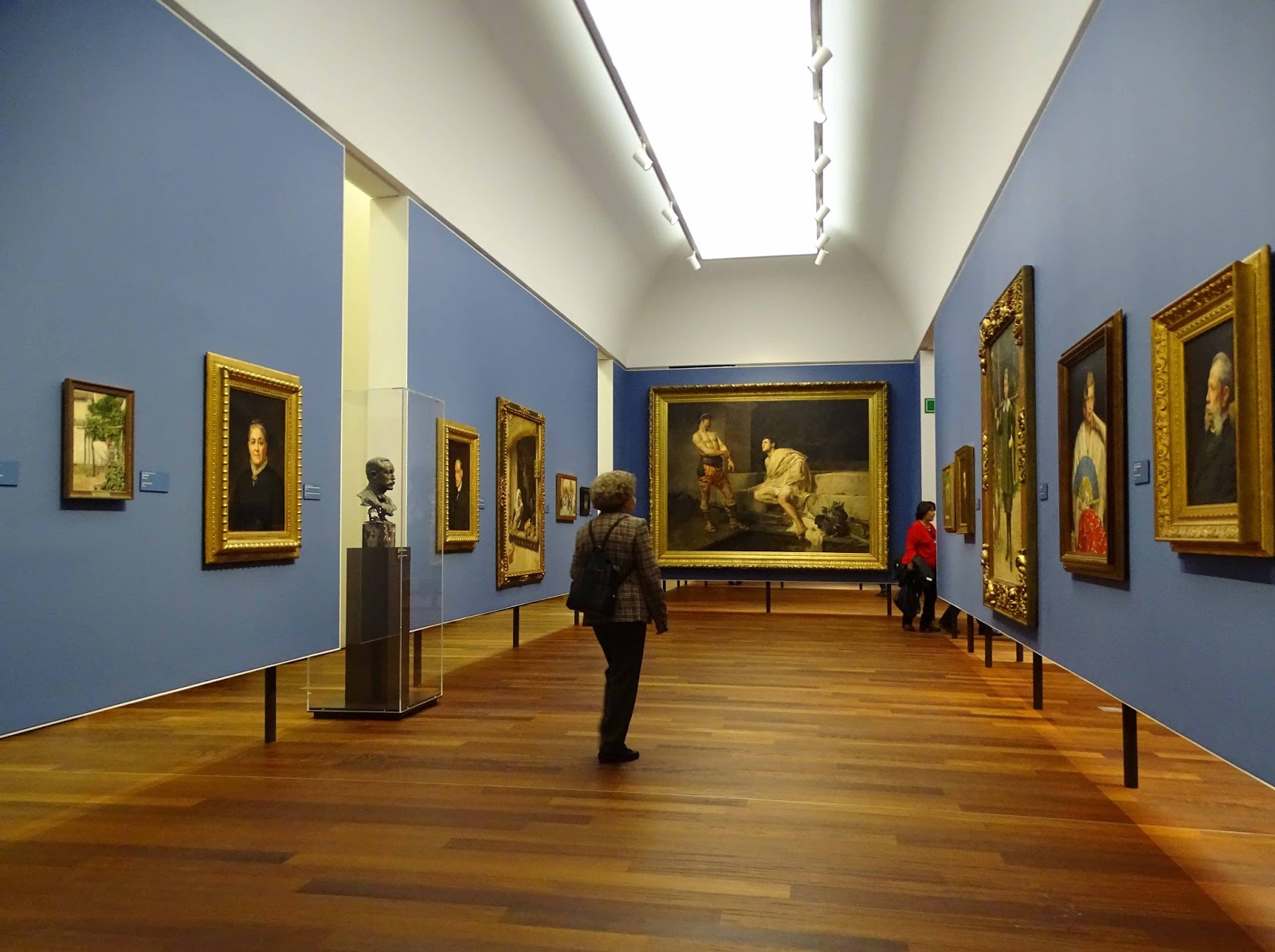

Bridging Emotion and Reality
While Romanticism and Realism may seem like polar opposites, they are two sides of the same coin, each offering a unique perspective on the human experience. The Romantic artworks, with their emphasis on emotion and imagination, invite viewers to embark on introspective journeys, while the Realist pieces, with their focus on tangible realities, encourage reflection on the world around us.
Modernism and Beyond: Breaking Boundaries
The turn of the 20th century heralded a new era in art, marked by a fervent desire to break free from traditional norms and explore uncharted territories of expression. The Museo de Malaga’s collection from the Modernist era and the subsequent avant-garde movements encapsulates this spirit of rebellion, innovation, and boundary-pushing.
Modernism: A Radical Departure
Modernism, as an artistic movement, was characterized by its bold experimentation with form, color, and technique. The collection’s Modernist pieces are a testament to this radical departure from convention. Artists began to challenge the very essence of representational art, opting for abstract forms, fragmented compositions, and innovative techniques. These artworks, whether they are vibrant paintings, sculptural marvels, or experimental installations, reflect the Modernists’ quest to capture the essence of the modern age, with its rapid industrialization, urbanization, and socio-cultural upheavals.
From the swirling patterns of Fauvism and the geometric precision of Cubism to the dreamlike landscapes of Surrealism, the Modernist artworks in the collection offer a kaleidoscope of styles and themes. They delve into the complexities of the human psyche, the chaos of the modern world, and the endless possibilities of artistic expression.
Beyond Modernism: The Avant-Garde Frontier
As art continued to evolve, the post-Modernist period saw the emergence of a plethora of avant-garde movements, each with its own unique philosophy and aesthetic. The collection’s pieces from this era showcase the diversity and dynamism of art in the 20th and 21st centuries.
Conceptual art, with its emphasis on ideas over aesthetics, challenged the very definition of art. Pop art, drawing inspiration from popular culture, blurred the lines between high art and mass media. Minimalism, with its pared-down aesthetics, sought to strip art down to its bare essentials. These movements, along with others like Abstract Expressionism, Neo-Expressionism, and Postmodernism, pushed the boundaries of what art could be, constantly redefining and reinventing artistic norms.
Also read our blog about: The Museums of Malaga: A Journey Through Art, History, and Innovation
A Celebration of Artistic Freedom
The Modernist and post-Modernist artworks in the Museo de Malaga’s collection are more than just visual delights; they are symbols of artistic freedom, courage, and innovation. They represent a time when artists dared to dream, to question, and to redefine the world around them. Through their groundbreaking works, they challenged societal norms, provoked thought, and paved the way for future generations of artists.
In essence, the “Modernism and Beyond” section of the Museo de Malaga is a celebration of art’s transformative power. It invites visitors to embark on a journey through time, witnessing the artistic revolutions that shaped the 20th and 21st centuries and marveling at the boundless creativity of the human spirit.
Contemporary Voices: Art in the Present
The collection’s contemporary section showcases works from the latter half of the 20th century to the present day. These artworks, diverse in their mediums and themes, capture the zeitgeist of contemporary Malaga. From mixed-media installations and digital art to thought-provoking sculptures and avant-garde paintings, these pieces offer commentary on modern society, politics, and culture.
Celebrating Local Talents
Integral to the Fine Arts Collection is its emphasis on local artists. Throughout the collection, works by Malagan artists are prominently featured, celebrating the city’s homegrown talent. These pieces, while influenced by global art trends, retain a distinct Malagan flavor, capturing the essence of the city’s landscapes, traditions, and people.
Interactive Exhibits and Multimedia
In the age of digital transformation and technological advancements, museums around the world are embracing innovative ways to engage and captivate their audiences. The Museo de Malaga is no exception. Its interactive exhibits and multimedia installations offer visitors a multi-sensory experience, allowing them to delve deeper into the narratives, explore art and history from fresh perspectives, and actively participate in the learning process.
Touch, Feel, and Engage: Discover Malaga Museum
No longer are visitors mere spectators, silently walking through corridors and gazing at exhibits from a distance. At the Museo de Malaga, they are invited to become active participants, immersing themselves in the rich tapestry of history, art, and culture. The museum’s state-of-the-art touchscreen displays provide a wealth of information at one’s fingertips. From detailed descriptions and historical contexts to animated reconstructions and expert commentaries, these digital interfaces offer a deeper dive into the exhibits, enhancing understanding and appreciation.
The tactile models, meticulously crafted to replicate original artifacts, offer a unique sensory experience. Visitors can touch, feel, and even manipulate these models, gaining insights into the craftsmanship, materials, and techniques of bygone eras. For those with visual impairments, these tactile elements provide an invaluable opportunity to connect with the exhibits in a meaningful way.
The hands-on stations scattered throughout the museum are hubs of activity and exploration. Here, visitors can don the hat of an archaeologist, piecing together fragments of ancient pottery or deciphering inscriptions. They can step into the shoes of an artist, experimenting with different mediums, styles, and techniques, or even recreating iconic artworks. For history enthusiasts, interactive dioramas and miniature models offer a chance to recreate pivotal historical moments, from grand battles to royal coronations.
Multimedia Projections: Malaga Museum Inovations
High-definition projections play a pivotal role in this multimedia experience. Spanning large sections of the museum’s walls, these projections vividly depict historical timelines, showcasing the progression of events, cultures, and artistic movements. The use of animation brings fluidity to these timelines, guiding visitors through epochs and eras with ease.
3D reconstructions are another highlight, offering a tangible sense of depth and dimension. Whether it’s a detailed model of an ancient city or a lifelike representation of a long-lost artifact, these reconstructions provide a tangible connection to the past. They allow visitors to virtually step into different time periods, exploring architectural marvels, bustling marketplaces, or serene landscapes of bygone eras.
Complementing the visual elements are captivating audio narratives. These auditory accompaniments, synchronized with the projections, provide context, anecdotes, and expert insights. The harmonious blend of sound and visuals ensures that the stories being told are not just seen but also heard and felt.
Moreover, the museum’s use of motion graphics and interactive elements adds an element of dynamism. Visitors can interact with certain displays, triggering animations, or accessing additional information, making the learning process more participatory.
Augmented Reality (AR) and Virtual Reality (VR) Experiences
With AR, the museum merges the digital realm with the physical. Visitors, using tablets or smartphones, can superimpose digital layers onto the actual exhibits. This interactive feature unveils hidden stories and insights, enriching the understanding of each artifact. For instance, pointing a device at an ancient sculpture might animate its history, revealing its original colors or showing it in its historical setting. This dynamic interaction between the tangible and digital worlds brings each exhibit to life, offering a richer, more engaging learning experience.
On the other hand, VR transports visitors to meticulously recreated virtual environments, providing a holistic sensory journey. By donning VR headsets, one can find themselves in the heart of an ancient marketplace, surrounded by the sounds and sights of the era, or inside an artist’s studio, witnessing the creation of a masterpiece. These experiences, encompassing sound, visuals, and sometimes even touch, allow visitors to not just observe but to live moments from different epochs.
The integration of these technologies signifies a monumental shift in the museum’s approach to presenting history and art.
Audio Guides and Interactive Apps
The Museo de Malaga, in its quest to offer an unparalleled visitor experience, has seamlessly integrated modern digital tools to cater to the diverse and tech-savvy audience of today. Recognizing the global appeal of its collections and the varied linguistic backgrounds of its visitors, the museum provides multilingual audio guides. These aren’t mere narrations; they are immersive experiences replete with captivating anecdotes, expert insights, and ambient sounds that transport listeners to different times and places, making each exhibit come alive.
Complementing these audio guides is the museum’s innovative suite of interactive apps, available for both Android and iOS platforms. Far from being just digital catalogues, these apps serve as personal tour companions. They offer features like self-guided tours, allowing visitors the freedom to explore at their own pace, delving deep into exhibits that intrigue them. The apps are also equipped with engaging quizzes, challenging users’ knowledge and offering a fun, interactive way to learn. Additionally, detailed interactive maps within the apps ensure effortless navigation through the museum’s vast corridors, ensuring visitors can easily locate and explore their points of interest.
Visiting the Museum: Practical Information
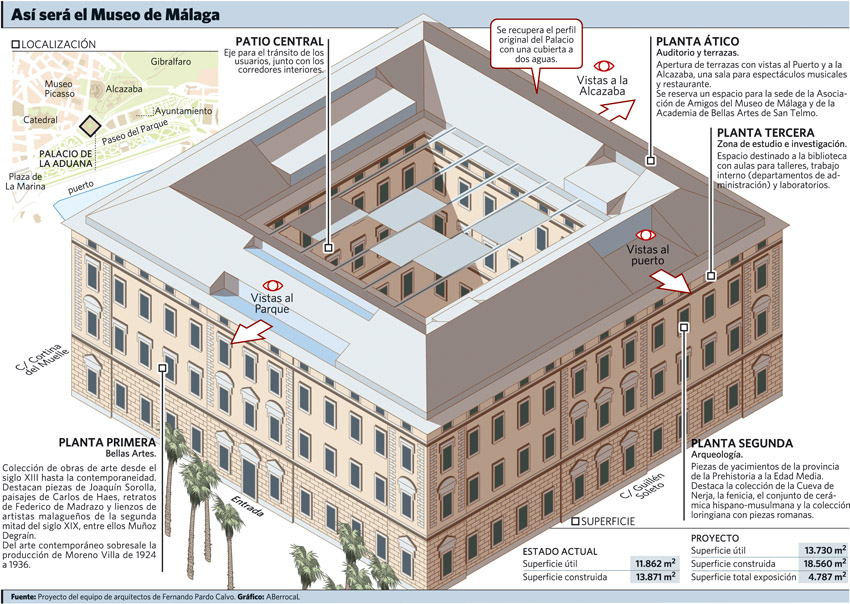

Location and Accessibility
Nestled in the heart of Malaga, the museum is easily accessible by public transport, including buses and trams. For those driving, there are several parking facilities nearby. The museum’s central location also means it’s within walking distance of other major attractions, making it a convenient stop in your city tour.
Timings of the Malaga Museum
The Museo de Malaga is open from Tuesday to Sunday, with Mondays being a weekly holiday. Operating hours are from 9:00 AM to 6:00 PM, with extended hours during the summer months. It’s advisable to check the museum’s official website for any changes in timings or special holiday hours.
Tickets and Pricing: Malaga Museum
Entry to the museum is ticketed, with different pricing for adults, children, and senior citizens. There are also family packages and group discounts available. On certain days of the month, the museum offers free entry, so it’s worth checking in advance.
Guided Tours
For those interested in a more in-depth exploration, the museum offers guided tours in multiple languages. These tours, led by expert guides, provide insights into the museum’s collections, the history of the exhibits, and interesting anecdotes.
Facilities
The museum is equipped with modern amenities to ensure a comfortable visit. There are restrooms, baby changing facilities, and lockers for storing personal belongings. For those with mobility challenges, the museum offers wheelchair access, elevators, and seating areas throughout the premises.


Cafeteria and Gift Shop: Malaga Museum
After exploring the exhibits, visitors can relax at the museum’s cafeteria, which offers a range of refreshments and light snacks. The adjacent gift shop is a must-visit, stocked with souvenirs, art reproductions, books, and other memorabilia that make for perfect keepsakes or gifts.
Visitor Etiquette
While photography is allowed, it’s requested that flash and tripods be avoided to preserve the integrity of the exhibits. Visitors are also encouraged to maintain silence in certain sections to ensure a serene environment for all.
Getting to the end…
The Museo de Malaga is not just a building filled with artifacts; it’s a living testament to the resilience and creativity of the people of Malaga. Through its exhibits, we’ve traveled across millennia, witnessing the ebb and flow of civilizations and the artistic and cultural renaissances that have left their mark on this city. As Manuel Rodriguez often reminds us, “History is not just about the past; it’s about understanding our roots to shape our future.” And as we step out of the museum, we carry with us a deeper appreciation for Malaga’s legacy and its enduring spirit.




